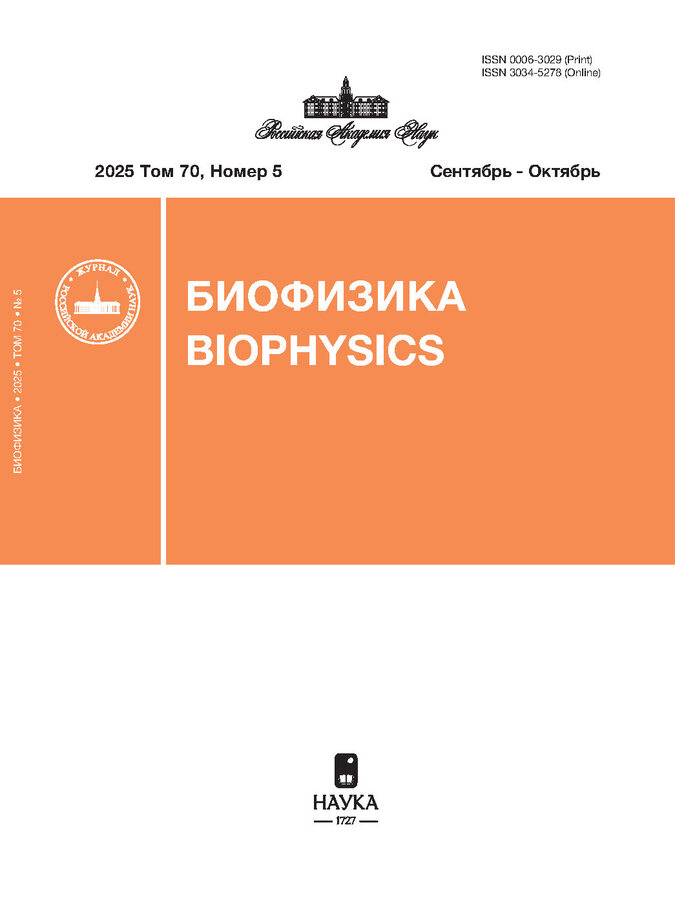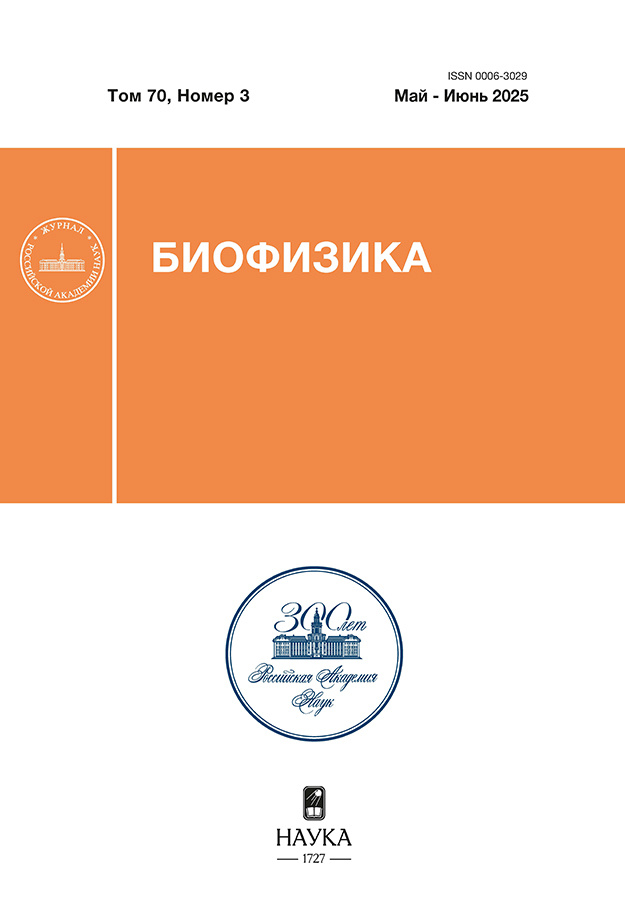Molecular Dynamic Modeling of Pharmacological Vector-Receptor Pairs for Specific Drug Delivery to the Tumor: Atomic-Molecular Mechanisms of RGD-Peptide Embedding in the αvβ3-Integrin Receptor
- Authors: Baigunov I.A1, Kholmurodov K.T1,2,3,4, Khusenzoda M.A5, Gribova E.D1, Polotnyanko N.A1, Mukhina I.V1, Gladyshev P.P1,6, Lipengolts A.A7
-
Affiliations:
- Dubna State University
- Frank Laboratory of Neutron Physics, Joint Institute for Nuclear Research
- Lomonosov Moscow State University
- S.U. Umarov Physical-Technical Institute
- Tajik Technical University named after academician M. Osimi
- Institute of Macromolecular Compounds, Russian Academy of Sciences
- National Medical Research Center of Oncology named after N.N. Blokhin, Ministry of Health of the Russian
- Issue: Vol 70, No 3 (2025)
- Pages: 453-470
- Section: Molecular biophysics
- URL: https://rjraap.com/0006-3029/article/view/687536
- DOI: https://doi.org/10.31857/S0006302925030047
- EDN: https://elibrary.ru/KSODWD
- ID: 687536
Cite item
Abstract
About the authors
I. A Baigunov
Dubna State UniversityDubna, Russia
Kh. T Kholmurodov
Dubna State University; Frank Laboratory of Neutron Physics, Joint Institute for Nuclear Research; Lomonosov Moscow State University; S.U. Umarov Physical-Technical Institute
Email: kholnirzg@gmail.com
Dubna, Russia; Dubna, Russia; Moscow, Russia; Dushanbe, Republic of Tajikistan
M. A Khusenzoda
Tajik Technical University named after academician M. OsimiDushanbe, Republic of Tajikistan
E. D Gribova
Dubna State UniversityDubna, Russia
N. A Polotnyanko
Dubna State UniversityDubna, Russia
I. V Mukhina
Dubna State UniversityDubna, Russia
P. P Gladyshev
Dubna State University; Institute of Macromolecular Compounds, Russian Academy of SciencesDubna, Moscow Region, Russia; Moscow, Russia
A. A Lipengolts
National Medical Research Center of Oncology named after N.N. Blokhin, Ministry of Health of the RussianMoscow, Russia
References
- Zhang Q., Radvak P., Lee J., Xu Y., Cao-Dao V., Zheng W., Chen C. Z., Xie H., and Ye Y. Mitoxantrone modulates a heparan sulfate-spike complex to inhibit SARS-CoV-2 infection. Sci Rep., 12 (1), 6294 (2022). doi: 10.1038/s41598-022-10293-x
- Направленный транспорт лекарственных веществ (тематический выпуск). Рос. хим. журнал (Журн. Рос. хим. об-ва им. Д. Н. Менделеева), 56, 1–162 (2012).
- Di Cristo L., Grimaldi B., Catelani T., Vazques E., Pompa P. P., and Sabella S. Repeated exposure to aerosolized graphene oxide mediates autophagy inhibition and inflammation in a three-dimensional human airway model. Mater. Today Bio., 6, 100050 (2020). doi: 10.1016/j.mtbio.2020.100050
- Yun Y. H., Lee B. K., and Park K. Controlled drug delivery: Historical perspective for the next generation. J. Control. Release, 219, 2–7 (2015). doi: 10.1016/j.jconrel.2015.10.005
- Mendes R. G., Bachmatiuk A., Buchner B., Cuniberti G., and Rümmell M. H. Carbon nanostructures as multifunctional drug delivery platforms. J. Mater. Chem. B, 1 (4), 401–428 (2013). doi: 10.1039/c2tb00085g
- Klusenov M. A., Dushanov E. B., Kholmurodov Kh. T., Zaki M. M., and Swellam N. H. On correlation effect of the van-der-waals and intramolecular forces for the nucleotide chain - metallic nanoparticles - Carbon nanotube binding. Open. Biochem. J., 10, 17–26 (2016). doi: 10.2174/1874091X016100010017
- Каньгин В. В., Кичигин А. И., Губанова Н. В. и Таскаев С. Ю. Возможности бор-нейтронозахватной терапии в лечении злокачественных опухолей головного мозга. Вестн. рентгенологии и радиологии, № 6, 36–42 (2015). doi: 10.20862/0042-4676-2015-0-6-142-142
- Taskaev S., Bessmeltsov V., Bikchurina M., Bykov T., Kasatov D., Kolesnikov I., Nikolaev A., Oks E., Ostreinov G., Savinov S., Shuklina A., Sokolova E., and Yushkov G. Measurement of the 10B(d,d0)8Be, 10B(d,d1)8Be*, 10B(d,p2)9Be*, 11B(d,d0)9Be, and 11B(d,d2)9Be* reactions cross-sections at the deuteron energies up to 2.2 MeV. Nucl. Instruments Methods Phys. Res., Section B: Beam Interactions with Materials and Atoms, 557, 165527 (2024).
- Kasatov D. A., Kolesnikov Y. A., Konovalova V. D., Porosov V. V., Sokolova E. O., Shchudin I. M., and Taskaev S. Y., Development of a system for forming a beam of cold neutrons for the VITA accelerating neutron source. Phys. Particles Nucl. Lett., 21 (3), 404–409 (2024).
- Taskaev S., Bessmeltsov V., Bikchurina M., Bykov T., Kasatov D., Kolesnikov I., Nikolaev A., Oks E., Ostreinov G., Savinov S., Shuklina A., Sokolova E., and Yushkov G. Measurement of the 11B(p,d0)8Be and the 11B(p,d1)8Be* reactions cross-sections at the proton energies up to 2.2 MeV. Nucl. Instruments Methods Phys. Res., Section B: Beam Interactions with Materials and Atoms, 555, 165490 (2024).
- Case D. A., Cheatham T. E. 3rd, Darden T., Gohlke H., Luo R., Merz K. M. Jr., Onufriev A., Simmerling C., Wang B., and Woods R. J. The Amber biomolecular simulation programs. J. Comput. Chem., 26 (16), 1668–1688 (2005). doi: 10.1002/jcc.20290
- Case D. A., Aktulga H. M., Belfon K., Cerutti D. S., Cisneros G. A., Cruzeiro V. W. D., Forouzesh N., Giese T. J., Gotz A. W., Gohlke H., Izadi S., Kasavajhala K., Kaymak M. C., King E., Kurtzman T., Lee T. S., Li P., Liu J., Luchko T., Luo R., Manathunga M., Machado M. R., Nguyen H. M., O'Hearn K. A., Onufriev A. V., Pan F., Pantano S., Qi R., Rahnamoun A., Risheh A., Schott-Verdugo S., Shajan A., Swails J., Wang J., Wei H., Wu X., Wu Y., Zhang S., Zhao S., Zhu Q., Cheatham T. E. 3rd, Roe D. R., Roitberg A., Simmerling C., York D. M., Nagan M. C., and Merz K. M. Jr. AmberTools. J. Chem. Inf. Model., 63 (20), 6183–6191 (2023). doi: 10.1021/acs.jcim.3c01153
- Lee T. S., Cerutti D. S., Mermelstein D., Lin C., LeGrand S., Giese T. J., Roitberg A., Case D. A., Walker R. C., and York D. M. GPU-Accelerated molecular dynamics and free energy methods in Amber18: Performance enhancements and new features. J. Chem. Inf. Model., 58 (10), 2043–2050 (2018). doi: 10.1021/acs.jcim.8b00462
- Models in bioscience and materials research: Molecular dynamics and related techniques. Ed. by Kh. Kholmurodov (Nova Science Publ. Ltd., 2013).
- Computational Materials and Biological Sciences. Ed. by Kh. Kholmurodov (Nova Science Publ. Ltd., 2015).
- PDB ID: 3ZE2. doi: 10.2210/pdb3ZE2/pdb
Supplementary files











